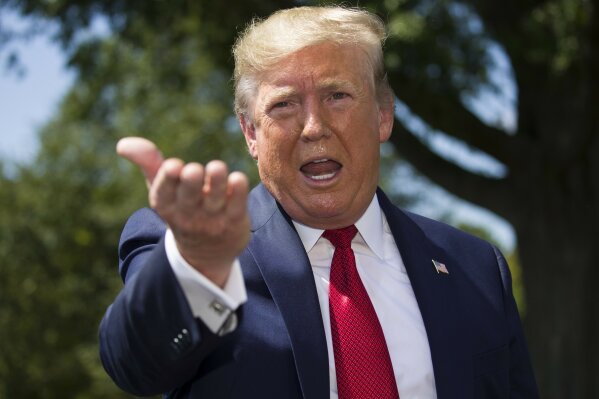Trump flip-flops on tax cuts, saying US has ‘strong economy’
WASHINGTON (AP) — A day after considering cutting taxes to promote economic growth, President Donald Trump changed course and said he would abandon the idea because the nation already had “a strong economy.”
Trump’s flip-flop on Wednesday came after recent market volatility and economic uncertainty, and amid a debate about whether the United States was heading for a slowdown that would imperil his reelection chances. Trump earlier this week acknowledged, for the first time, that his China trade policies may mean economic pain for Americans, though he insisted the tariffs are needed for more important long-term benefits.
But his consideration of cutting payroll taxes appeared short-lived.
“I’m not looking at a tax cut now,” he told reporters at the White House. “We don’t need it. We have a strong economy.”
Trump also knocked down the idea of indexing to the capital gains tax, which applies when investors sell assets, to inflation. He said he feared “it will be perceived, if I do it, as somewhat elitist.”
Analysts have warned that a slowdown, if not full-blown recession, could hit before next year’s election. Trump, however, has largely praised the economy’s performance and his handling of it. He has often blamed the Federal Reserve (and Chairman Jerome Powell) and the global slowdown for creating dark clouds at home.
“Jay Powell and the Federal Reserve have totally missed the call. I was right and just about everybody admits that,” Trump said Wednesday. “He raised interest rates too fast, too furious, and we have a normalized rate. And now we have to go the other direction.”
Some White House advisers fear Trump has undercut Powell’s credibility. They worry that the president’s calls for rate cuts and his discussion of indexing or a payroll tax cut could spook, rather than reassure markets.
Trump indicated he had no choice but to impose the trade penalties that have been a drag on U.S. manufacturers, financial markets and, by some measures, American consumers.
“Somebody had to do it. I am the chosen one,” Trump said on the White House lawn, looking skyward. “Somebody had to do it. So, I’m taking on China. I’m taking on China on trade.”
China, though, said trade with the U.S. has been “mutually beneficial” and appealed to Washington to “get along with us.” A foreign ministry spokesman, Geng Shuang, expressed hope Washington can “meet China halfway” in settling disagreements.
The U.S. economy appears to be showing vulnerabilities after more than 10 years of growth. Factory output has fallen and consumer confidence has waned as he has ramped up his trade fight with China.
Trump rattled the stock and bond markets this month when he announced plans to put a 10% tax on $300 billion worth of Chinese imports. The market reaction suggested a recession might be on the horizon and led Trump to delay some of the tariffs that were scheduled to begin in September, though 25% tariffs are already in place for $250 million in other Chinese goods.
The president has long maintained that the burden of the tariffs is falling solely on China, yet that message was undermined by his statements to reporters Tuesday. “My life would be a lot easier if I didn’t take China on,” Trump said. “But I like doing it because I have to do it.”
The world economy has been slowing in recent months, and recent stock market swings have added to concerns that the U.S. economy is not immune. A survey Monday showed a big majority of economics expect a downtown to hit by 2021.
Addressing that possibility, Trump focused anew on pressuring the Fed to cut interest rates. Presidents have generally avoided criticizing the central bank publicly. Trump, however, has shown no inclination to follow that lead, positioning Powell to take the fall if the economy swoons.
“I think that we actually are set for a tremendous surge of growth, if the Fed would do its job,” Trump said. “That’s a big if.” Trump recommended a minimum cut of a full percentage point in the coming months.


